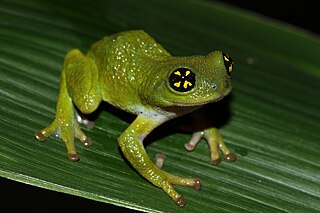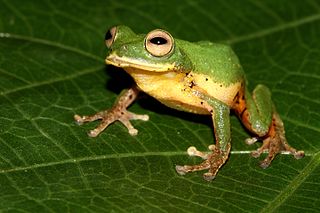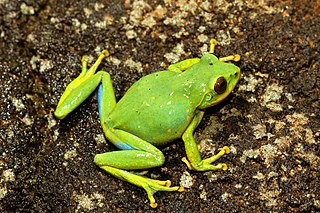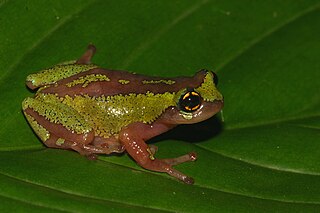
Chytridiomycosis is an infectious disease in amphibians, caused by the chytrid fungi Batrachochytrium dendrobatidis and Batrachochytrium salamandrivorans. Chytridiomycosis has been linked to dramatic population declines or extinctions of amphibian species in western North America, Central America, South America, eastern Australia, east Africa (Tanzania), and Dominica and Montserrat in the Caribbean. Much of the New World is also at risk of the disease arriving within the coming years. The fungus is capable of causing sporadic deaths in some amphibian populations and 100% mortality in others. No effective measure is known for control of the disease in wild populations. Various clinical signs are seen by individuals affected by the disease. A number of options are possible for controlling this disease-causing fungus, though none has proved to be feasible on a large scale. The disease has been proposed as a contributing factor to a global decline in amphibian populations that apparently has affected about 30% of the amphibian species of the world. Some research found evidence insufficient for linking chytrid fungi and chytridiomycosis to global amphibian declines, but more recent research establishes a connection and attributes the spread of the disease to its transmission through international trade routes into native ecosystems.

Raorchestes annandalii is a species of frog in the family Rhacophoridae. It is found in the eastern Himalayas in India, Nepal, and Bhutan. Its natural habitats are subtropical or tropical moist montane forests and subtropical or tropical high-altitude shrubland. It has been observed as high as 2700 meters above sea level. It relies on saltation to move around.

Raorchestes chalazodes is a species of critically endangered frog in the family Rhacophoridae. Raorchestes chalazodes is a nocturnal and arboreal species found in the understorey of tropical moist evergreen forest and is endemic to the Western Ghats of India. The specific name chalazodes is composed of the Greek word χάλαζα (chalaza) meaning "lump" and -odes for the derived adjective, reflecting white granulation of the body. It has been observed between 1200 and 1600 meters above sea level.

Raorchestes flaviventris is a species of arboreal, nocturnal, frog of the family Rhacophoridae. It is endemic to the Western Ghats, South India. Its common names are yellow-bellied bush frog and Malabar bubble-nest frog.

Raorchestes griet is a species of frog in the family Rhacophoridae. It is endemic to the Western Ghats south of the Palghat Gap in Kerala and Tamil Nadu states, India. The specific name griet honours Griet Decock, spouse of Franky Bossuyt, the scientist who described the species. The common name Griet bush frog has been coined for it.

Raorchestes nerostagona is a species of frog in the family Rhacophoridae. It is endemic to the Western Ghats, India. It has been called as the Kalpetta yellow bush frog or lichen bush frog for its patchy lichen like patterning that make it cryptic. First described in 2005 based on a specimen obtained in Kalpetta, the species has subsequently been found in many parts of the Western Ghats. This frog has been observed between 900 and 1200 meters above sea level.

Raorchestes munnarensis is a species of frog in the family Rhacophoridae endemic to Munnar, Kerala, along the Ghat road to Devikulam in the southern Western Ghats, India.

The golden toad is an extinct species of true toad that was once abundant in a small, high-altitude region of about 4 square kilometres (1.5 sq mi) in an area north of the city of Monteverde, Costa Rica. It was endemic to elfin cloud forest. Also called the Monte Verde toad, Alajuela toad and orange toad, it is commonly considered the "poster child" for the amphibian decline crisis. This toad was first described in 1966 by herpetologist Jay Savage. The last sighting of a single male golden toad was on 15 May 1989, and it has since been classified as extinct by the International Union for Conservation of Nature (IUCN).

Raorchestes kakachi is a species of frogs in the family Rhacophoridae. It is endemic to the southern Western Ghats of India. The specific name kakachi refers to the type locality from where the species was described.

Raorchestes chotta, also known as the small bushfrog or small bush frog, is a species of frog found only in Ponmudi in the Western Ghats of Kerala, India. This frog lays eggs attached to the underside of a leaf. They hatch as tiny froglets, skipping the tadpole stage. The frog has been observed between 600 and 980 meters above sea level.

Raorchestes jayarami, also known as Jayaram's bush frog, is a species of frog from the subfamily rhacophoridae found in Valparai in the Western Ghats of Tamil Nadu in India, where it has been observed between 600 and 1800 meters above sea level.

Raorchestes johnceei is a species of frog of the genus Raorchestes found in Bonacaud in the Western Ghats of Kerala in India. It has been observed between 900 and 1300 meters above sea level.

Raorchestes kadalarensis is a species of frog of the genus Raorchestes found in Kadalar near Munnar in the Western Ghats of Kerala in India. This frog has been observed between 1300 and 1700 meters above sea level.

Raorchestes honnametti is a species of frog in the family Rhacophoridae that is described from the Biligiri Rangaswamy Tiger Reserve in Karnataka. This frog has been observed between 600 and 1800 meters above sea level.

Raorchestes hassanensis, the Hassan bush frog or Dutta's bubble-nest frog, is a species of frog in the family Rhacophoridae. It is endemic to India, including the Western Ghats.
Raorchestes primarrumpfi is a species of frog in the family Rhacophoridae. It is endemic to India and has been observed high in the Nilgiri Massif mountains.
Roarchestes leucolatus is a species of frog in the family Rhacophoridae. It is endemic to India. Scientists have observed it in the Western Ghat mountains, between 894 and 958 meters above sea level.

Roarchestes blandus or the Anamalai bush frog is a species of frog in the family Rhacophoridae. It is endemic to India. Scientists have observed it in the Western Ghat mountains, between 45 and 806 meters above sea level.

Roarchestes indigo is a species of frog in the family Rhacophoridae. It is endemic to India. It has been observed high in the mountains in scrub tree habitats. This frog has been observed between 1400 and 1700 meters above sea level.

Raorchestes flaviocularis is a species of frog in the family Rhacophoridae. It is endemic to India. It has been observed between 1459 and 1569 meters above sea level in the Western Ghat mountains. It has been observed between 1400 and 1600 meters above sea level.



















